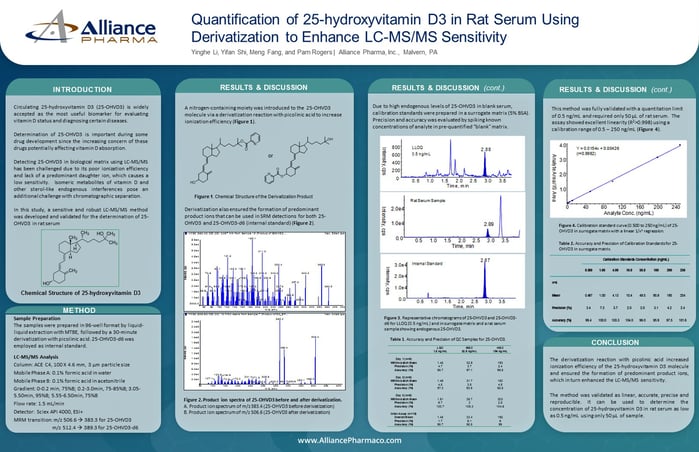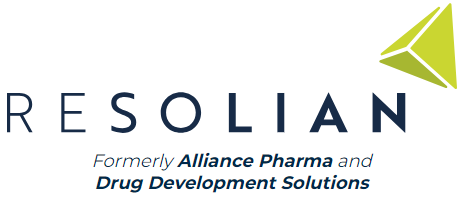Circulating 25-hydroxyvitamin D3 (25-OHVD3) is widely accepted as the most useful biomarker for evaluating vitamin D status and diagnosing certain diseases.
Determination of 25-OHVD3 is important during some drug development since the increasing concern of these drugs potentially affecting vitamin D absorption.
Detecting 25-OHVD3 in biological matrix using LC-MS/MS has been challenged due to its poor ionization efficiency and lack of a predominant daughter ion, which causes a low sensitivity. Isomeric metabolites of vitamin D and other sterol-like endogenous interferences pose an additional challenge with chromatographic separation.
In this study, a sensitive and robust LC-MS/MS method was developed and validated for the determination of 25-OHVD3 in rat serum.

Sample Preparation
The samples were prepared in 96-well format by liquid-liquid extraction with MTBE, followed by a 30-minute derivatization with picolinic acid. 25-OHVD3-d6 was employed as internal standard.
LC-MS/MS Analysis
Column: ACE C4, 100 X 4.6 mm, 3 µm particle size
Mobile Phase A: 0.1% formic acid in water
Mobile Phase B: 0.1% formic acid in acetonitrile
Gradient: 0-0.2 min, 75%B; 0.2-3.0min, 75-85%B; 3.05-5.50min, 95%B; 5.55-6.50min, 75%B
Flow rate: 1.5 mL/min
Detector: Sciex API 4000, ESI+
MRM transition: m/z 506.6 à 383.3 for 25-OHVD3
m/z 512.4 à 389.3 for 25-OHVD3-d6
Bioanalysis Results
A nitrogen-containing moiety was introduced to the 25-OHVD3 molecule via a derivatization reaction with picolinic acid to increase ionization efficiency (Figure 1).
Derivatization also ensured the formation of predominant product ions that can be used in SRM detections for both 25-OHVD3 and 25-OHVD3-d6 (internal standard) (Figure 2).
Due to high endogenous levels of 25-OHVD3 in blank serum, calibration standards were prepared in a surrogate matrix (5% BSA). Precision and accuracy was evaluated by spiking known concentrations of analyte in pre-quantified “blank” matrix.
Figure 3. Representative chromatograms of 25-OHVD3 and 25-OHVD3-d6 for LLOQ (0.5 ng/mL ) and in surrogate matrix and a rat serum sample showing endogenous 25-OHVD3.
This method was fully validated with a quantitation limit of 0.5 ng/mL and required only 50 mL of rat serum. The assay showed excellent linearity (R2>0.998) using a calibration range of 0.5 – 250 ng/mL (Figure 4).
Conclusion
The derivatization reaction with picolinic acid increased ionization efficiency of the 25-hydroxyvitamin D3 molecule and ensured the formation of predominant product ions, which in turn enhanced the LC-MS/MS sensitivity.
The method was validated as linear, accurate, precise and reproducible. It can be used to determine the concentration of 25-hydroxyvitamin D3 in rat serum as low as 0.5 ng/mL using only 50 mL of sample.
Scientists
Yinghe Li, Yifan Shi, Meng Fang, and Pam Rogers







